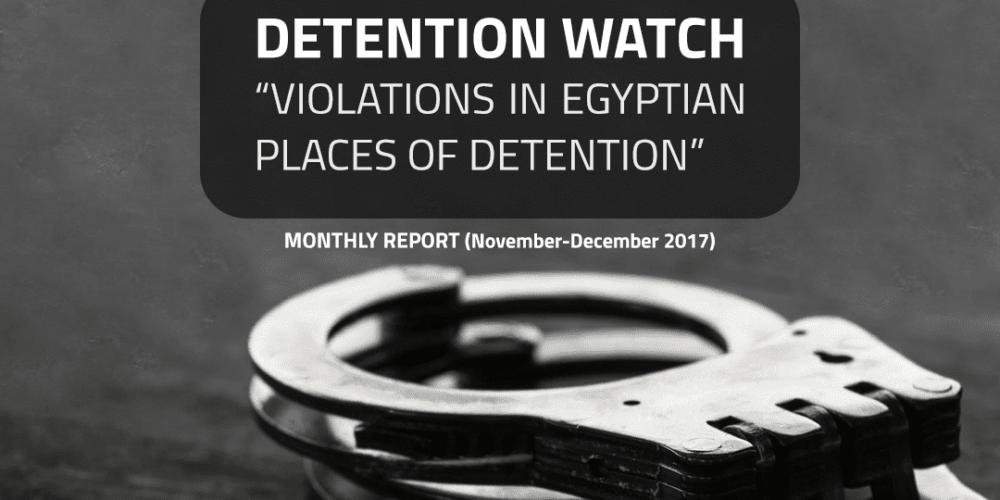Following CfJ’s six reports on human rights violations against detainees in Egyptian detention places for the first ten months of 2017 (January and February, March and April, May, June and July, August, September and October)[1]; Detention Watch project proceeds in this issue to provide an analytical overview of the human rights situation in Egyptian detention places – formal and informal – during the months of November and December 2017; while holding the authorities accountable of their obligations mandated by law (Egyptian constitution, Egyptian criminal law, and international human rights treaties Egypt has signed).
The end objective of such periodic reports is to
- inform national and international stakeholders of the ongoing conditions inside places of detention,
- enable families of victims and detainees to factually establish claims of illegal and inhumane circumstances that are endured,
- engage or demand engagement of authorities into a dialogue that can formulate coherent and consistent strategies and legislations that put an end to such violations,
- support prevention of impunity of human rights violations in places of detention,
- contribute to the transitional justice mechanisms that this country will or might employ at a later stage
The methodology of this activity primarily entailed monitoring and observing violations being reported formally and informally on a day-to-day basis. After collecting the primary data, the project team employed the verification tool; a step that is regrettably overlooked by many other human rights organizations reporting in the same field due to difficulties establishing contact, time consumption and risks associated. Authenticating the data collected is a crucial step to safeguard the credibility of the data presented, and to be able to legally hold the violators accountable with proof. Accordingly, it was imperative for Detention Watch to communicate with the families of each detainee who suffered a violation and verify all the information needed. All the gathered data whether monitored or verified were finally compiled in this report with a contextual and statistical analysis; while shedding light on the challenges and limitations handled while working on the material.
Key findings that Detention Watch reached can be summarized as follows:
- 220 incidents of violations in detention places were monitored in November 2017. In December 2017, 208 incidents of violations were recorded.
- Out of those 220 cases in November, an 88% rate of enforced disappearance cases was recorded (193), 5% rate of monitored medical negligence cases (12 cases), 2% rate of extrajudicial killings (5 cases), 2% rate of torture (5 cases), and 2% rate of medical negligence leading to death with 5 cases.
- Beheira Governorate is responsible for 31 of the monitored enforced disappearance cases and is followed closely by Sharqia Governorate with 30 reported enforced disappearance incidents.
- Out of 208 cases in December, 89% rate of monitored enforced disappearance (186 cases), 5% for medical negligence violations with 10 cases, 2% medical negligence that led to death with 10 cases, torture and extrajudicial killings have 3 reported cases each amounting to 2% and torture that led to death with 1 reported case at 1% of total reported violations.
- Sharqia Governorate has the highest number of enforced disappearance with 46 reported arrests and disappearance (24.7%). Followed by Kafr El-Sheikh with 31 cases (16.6%)
- CFJ monitored 23 deaths in detention places in Minya throughout 2017. 18 out of the 23 deaths took place in Minya Maximum Security Prison, and 10 out of those 18 deaths are due to medical negligence.
- CFJ documented 48 incidents of violations targeted at 42 detainees across detention places in Egypt in November and December 2017.
- Enforced disappearance is the number one violation with a 68.7% of all documented violations. Followed by, medical negligence at 16.6% and torture with a 10.4% , death due to medical negligence and arbitrary detention at 2% each.
- Scorpion Prison has the highest number of violations these two months at 4 violations with 8.3% of all documented violations.
- 35 out of 42 detainees were subjected to enforced disappearance (83% of all the verified detainees).
- In 7 out of the 8 documented medical negligence cases, the detainees are not allowed their medication.
- The age group facing the highest number of violations monitored is the youth group (16-30), followed by the middle age group (31-50), then finally the elderly (above 50)
- In 86% of the cases (30 out of 35 verified enforced disappearance cases) that suffered enforced disappearance, they were arrested by State Security Officers.
[1]Link referencing Detention Watch Jan and Feb, Detention Watch March and April, Detention Watch May, Detention Watch June and July, Detention Watch August, Detention Watch September and October






